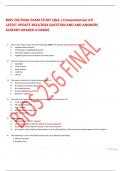BIOS 256 FINAL EXAM STUDY Q&A | Comprehensive ATI
LATEST UPDATE 2023/2024 QUESTION AND AND ANSWERS
ALREADY GRADED A GRADE.
1 The urinary system does all of the following, EXCEPT it A secretes excess glucose molecules
B regulates blood volume
C contributes to stabilizing blood pH
D eliminates organic waste products
E regulates plasma concentrations of electrolytes
2 Conical structures that are located in the renal medulla are called
A pyramids
B renal columns
C renal pelvises
D nephrons
E calyces
3 The region known as the macula densa is part of
A the proximal convoluted tubule
B the distal convoluted tubule
C the collecting duct
D the ascending loop of Henle
E Bowman’s capsule
4 The cells of the macula densa and the juxtaglomerular cells form the
A renal corpuscle
B filtration membrane
C loop of Henle
D juxtaglomerular apparatus
E afferent arteriole
5 A glomerulus is
A the expanded end of a nephron
B a knot of capillaries that lies within the renal corpuscle
C the portion of the nephron closest to the renal corpuscle
D the portion of the nephron that attaches to the collecting duct E the horseshoe-shaped segment of the nephron
6 The following is a list of the blood vessels that carry blood to the kidney.
1. afferent arteriole
2. arcuate artery
1|Page
, BIOS 256 FINAL EXAM STUDY Q&A | Comprehensive ATI
3. interlobar artery
4. renal artery
5. glomerulus
6. interlobular artery
7. efferent arteriole
8. peritubular capillary
The proper order in which blood passes through these vessels is
A 4, 6, 2, 3, 1, 5, 7, 8
B 4, 3, 2, 6, 1, 5, 7, 8
C 4, 3, 2, 6, 7, 5, 1, 8
D 4, 6, 2, 3, 7, 5, 1, 8
E 4, 3, 6, 2, 1, 5, 7, 8
7 The process of filtration is driven by
A active transport
B blood osmotic pressure
C blood hydrostatic pressure
D renal pumping
8 The mechanisms for maintaining the solute concentration gradient in the renal medulla require A active
transport of sodium and chloride ions from the ascending limb of the loop of Henle
B active transport of sodium and chloride ions from the ascending limb of the vasa recta
C the ascending limb of the loop of Henle to be permeable to water
D the vasa recta to be impermeable to water E both A and B
9 Which of the following is greater?
A the concentration of solute in the filtrate at the beginning of the loop of Henle
B the concentration of solute in the filtrate at the bottom of the descending limb of the loop of Henle
1 The antidiuretic hormone
0
A increases the permeability of the collecting ducts to water
B is secreted in response to low concentrations of potassium ions in the extracellular fluid.
C causes the kidneys to produce a larger volume of relatively solute-free urine
D helps regulate the concentration of potasium ion in the interstitial space
E is sensitive to changes in the blood concentrations of both sodium and potassium
1 In the loop of Henle
1
A water is secreted into the descending limb
B sodium and chloride ions are actively transported out of the ascending limb
C the ascending limb is very permeable to water
D the filtrate in the descending limb becomes more and more hypotonic E filtrate is produced
2|Page
, BIOS 256 FINAL EXAM STUDY Q&A | Comprehensive ATI
1 Which hormone stimulates the thirst mechanism most?
2
A ADH
B aldosterone
C ANP
D BNP
E natriuretic peptide
1 All of the following are components of ECF, except
3
A cerebral spinal fluid
3|Page




